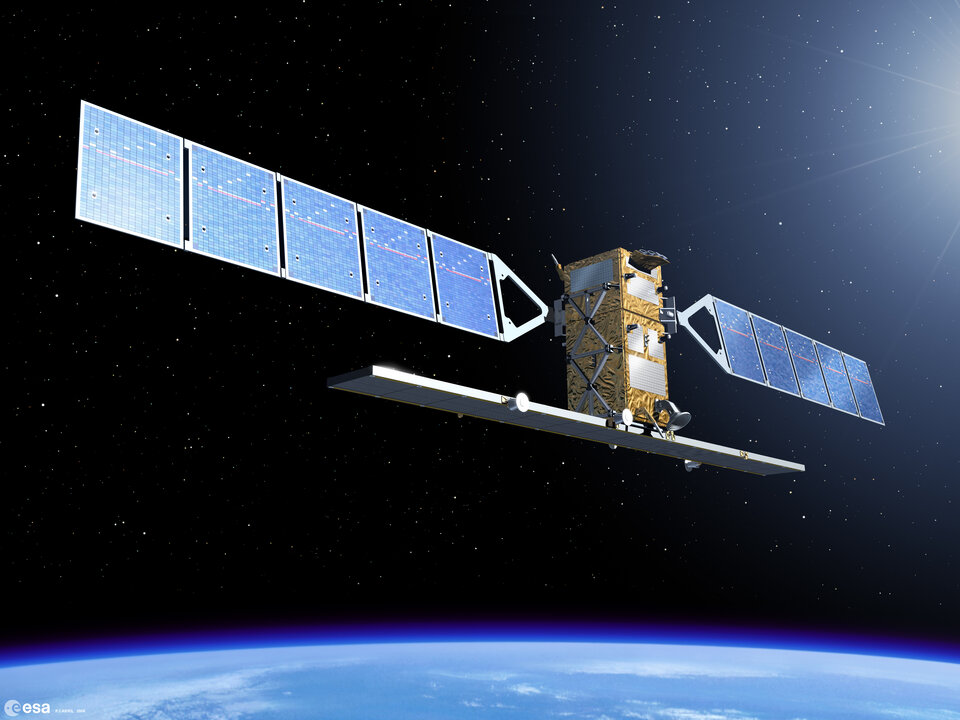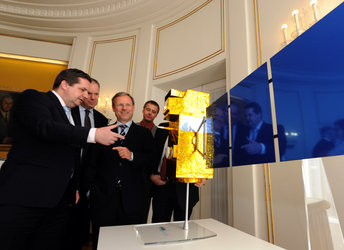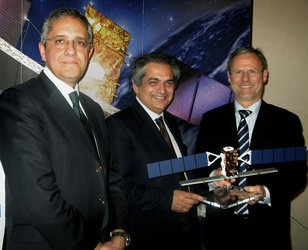Great strides for GMES
While the recent Living Planet Symposium focused mainly on the latest findings on Earth's environment and climate using data from Earth observation satellites, it also provided the forum to present the progress that the GMES initiative has made since the last symposium in 2007.
Conceived in 1998, the Global Monitoring for Environment and Security (GMES) initiative is arguably the most ambitious Earth observation programme to date. It relies on data from satellites, aircraft and from the ground to provide accurate and timely information to help manage the environment more effectively.
Under the leadership of the European Commission, the objective is to deliver operational information services for six main disciplines: land, oceans, atmosphere, emergency response, security and climate change. To help achieve this, ESA is responsible for the 'Space Component', which includes the development of five new families of satellites called Sentinels.

Interest in the GMES initiative was clearly demonstrated at the Living Planet Symposium as the dedicated sessions, which spanned two days, were often packed out.
Josef Aschbacher, Head of ESA's GMES Space Office said that, "We are very proud of the progress that GMES has made since the last meeting of this kind – the Envisat Symposium in 2007. We are rapidly moving forward from the research and development phases and coming much closer to operations.
"GMES is a large and complex undertaking, but there will be great benefits to Europe and, indeed, the world. The six GMES sessions at the symposium in Norway have been full to capacity with participants showing great interest in what the initiative has to offer. It is exciting to see such an enthusiasm about GMES in the community."

One of the most important milestones that has been reached since the last symposium relates to the funding of the Space Component. At the 2008 Ministerial Council, ESA Member States committed a further €831 million bringing the total budget to €2.3 billion. ESA Member States now provide 72% of this total and the European Commission provides 28%.
With the budget secured, contracts for the three pairs of Sentinel-1, Sentinel-2 and Sentinel-3 satellites were subsequently placed. This means that the first 'A units' of the three missions are expected to launch within the 2012–2013 timeframe. These three missions are planned to orbit as pairs to maximise coverage. In addition, contracts have been placed for the early phase studies for Sentinel-4 and Sentinel-5 Precursor.
The Sentinels carry different instrument packages: Sentinel-1 is a radar imaging mission for land and ocean services, Sentinel-2 is a multispectral high-resolution imaging mission for land monitoring and Sentinel-3 is a multi-instrument mission primarily for marine services. Sentinels-4/-5 will provide data to monitor the atmosphere and Sentinel-5 Precursor is designed to fill the gap between Envisat and Sentinel-5, for SCIAMACHY data in particular.

While much of the focus at the symposium was on the status of the recently launched Earth Explorer satellites, which are designed to deliver data to advance our understanding of Earth, there was also much interest in the status of the families of Sentinels and their delivery of operational data – as noted by two symposium participants:
Speaking about Sentinel-1, Prof Ramon Hanssen from the Delft University of Technology in the Netherlands said, "This mission will be a major leap forward for solid Earth sciences and applications, such as monitoring deformation in volcanically active areas. In order to monitor volcanic cycles, observation sampling needs to be frequent, regular and conducted over long periods of time. In full constellation, Sentinel-1 will offer this through its high repeat and revisit frequencies and the fact that its main mode of operation will be interferometric wide swath."
Prof. Jose Moreno from the University of Valencia in Spain said, "When flying in full formation, Sentinel-2 will open up new possibilities for applications in land science. The mission will provide for the first time a reliable source of data at adequate spatial and temporal resolution and coverage, and should produce a long time series of data. In particular, the data will help overcome current limitations the radiative and eco-physiological components in models so that important processes and feedbacks are better described."
Another milestone, in terms of progress, has been the release of contracts for the ground segment to prepare for Sentinel data acquisition, processing and dissemination. These ground segment activities are complimented by the work already undertaken to develop the data access portal to handle the other missions contributing to GMES defined as 'Contributing Missions'.

GMES will offer a host of services, not only for environmental management, but also to improve the daily lives of European citizens. For example, services relating to the atmosphere are being developed within the European Commission's Seventh Framework Programme (FP7) MACC project.
One such service – the European Air Quality Forecast Service – will be used by downstream service providers to provide practical information. The Pasodoble project, for instance, works with doctors, pharmacists and hospital staff to predict poor air quality and advocates preventative medicine for those at risk.

GMES is a unique endeavour – combining satellite and in situ data to optimise such domains as agriculture, fisheries, ship navigation and safety, urban planning, humanitarian aid, to name but a few. While much progress has been made, the initiative remains a complex and expansive undertaking with challenges ahead – primarily associated with future funding, which is still to be secured.











